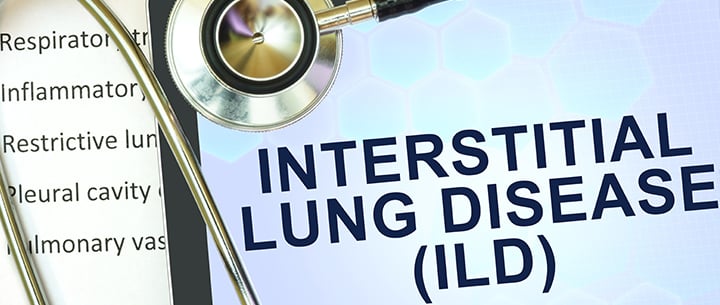Interstitial lung disease (ILD) is a group of medical conditions characterized by lung scarring. Several factors can cause ILD, including exposure to toxic substances. Asbestosis is an interstitial lung disease caused by asbestos exposure and inhalation of asbestos fibers.
If you suffer from mesothelioma, asbestos-related lung cancer, or asbestosis, you may be eligible for substantial compensation. There is currently over $30 billion in asbestos trust funds set up for victims of asbestos-related diseases. We invite you to fill out our form today for a free Financial Compensation Packet, filled with information about experienced mesothelioma lawyers in your area, how to get paid in 90 days, how to file an asbestos trust fund claim and much more.


FREE Financial Compensation Packet
- Info on law firms that will recover your HIGHEST COMPENSATION
- Learn how to get paid in 90 days
- File for your share of $30 billion in trust funds

What Is Interstitial Lung Disease?
Interstitial lung disease is a term used to describe a group of diseases that cause scar tissue to form in the lungs. Another term for this scarring is fibrosis. Fibrosis makes lung tissue stiff and less elastic. This makes it more difficult for the lungs to expand and for a person to breathe.
The fibrosis in ILDs occurs around the air sacs in the lungs, known as alveoli. This is also known as the interstitial space. This is the space in which oxygen exchange occurs. Scarring makes it more difficult for this process to occur. ILDs are progressive, meaning they get worse with time.
There are more than 100 ILDs with various causes, or in some cases, no known cause. Some examples of ILDs include:
- Asbestosis, caused by asbestos exposure
- Silicosis, caused by exposure to silica dust
- Pneumoconiosis, also known as black lung disease, caused by coal dust and common in miners
- Desquamative interstitial pneumonitis, often caused by smoking
- Sarcoidosis, caused by inflammation
What Causes Interstitial Lung Disease?
ILD is often caused by exposure to toxins like asbestos, typically prolonged exposure. In addition to asbestos fibers, ILD has been associated with bird feces, grain dust, and silica dust.
Some medical conditions can also cause ILD. Along with asbestosis, other conditions associated with ILD include rheumatoid arthritis, lupus, sarcoidosis, and scleroderma.
Further, certain medications have been linked to ILD, including:
- Antibiotics: Certain antibiotics, such as sulfasalazine and nitrofurantoin, can lead to lung damage
- Heart Medicine: Heart medication, such as propranolol and amiodarone have been associated with harming lung tissue
- Chemotherapy Medication: Chemotherapy drugs, including cyclophosphamide and methotrexate, have been linked with lung damage
Sometimes, the cause of ILD is unknown. When the cause is unknown, physicians call it idiopathic interstitial lung disease or sometimes idiopathic pulmonary fibrosis.
Once the lung scarring begins, it’s difficult for physicians to cure it. Medication and other treatments slow down the condition, but the existing damage is irreversible.
This is unfortunate for those with asbestosis, as it generally takes 30 to 50 years before an asbestos-related disease is diagnosed, and lung damage is usually always severe.
Asbestosis
Asbestosis is ILD caused by asbestos exposure. Asbestos releases tiny fibers that, when inhaled, get stuck in tissue in the respiratory system. This can lead to cancer or non-malignant scarring that causes asbestosis.
Not everyone exposed to asbestos will get sick, but repeated, prolonged exposure is more likely to cause asbestosis. Workers who handled or worked around asbestos for years are at high risk for developing asbestosis.
What Are the Symptoms of Interstitial Lung Disease?
ILD symptoms are essentially the same symptoms of asbestosis and other lung-related disorders:
- Coughing and chest pain
- Coughing
- Shortness of breath, more pronounced with exertion
- Fatigue and a general feeling malaise
- Clubbed fingers or toes
- Unexplained weight loss
Complications of Interstitial Lung Disease
The most common symptom of ILD is difficulty breathing. This results in inadequate oxygen intake and absorption. ILD can also cause other serious complications, especially when not treated or managed well:
- Pulmonary hypertension
- Heart failure
- Respiratory failure
- Pleural plaques
- Pleural effusion
Interstitial Lung Disease Risk Factors
Although ILD can affect anyone exposed to toxins or via other conditions, certain risk factors make people more susceptible:
- Oxygen Therapy: Oxygen therapy is a risk factor, but only when continuously inhaling high levels of therapeutic oxygen for 48 hours or more.
- Smoking: Smoking can increase the likelihood of developing ILD, but usually when another underlying condition exists.
- Age: Although ILD can affect anyone at any age, adults are more likely to develop the disease.
Can Interstitial Lung Disease Be Prevented?
Past exposure to toxins that cause ILD cannot be reversed. But, reducing ongoing risk factors reduces the chances of developing an ILD. Protective gear and following safety guidelines when working around substances like asbestos are the best ways to prevent an ILD.
Also vital is not smoking. Smoking can cause an ILD. It can also worsen interstitial lung disease, causing it to progress further.
Exposure to substances that cause ILDs most often occurs at work, but residential buildings can cause exposure, too. Be aware of potential toxins in your home, work with professionals to test for them, and manage these substances as needed.
How Is Interstitial Lung Disease Diagnosed?
Diagnosing ILD has proven difficult and often tricky for physicians. Since it mimics so many other lung-related disorders, doctors usually perform a series of scans, tests, and physicals to diagnose it, including:
Chest X-rays and Imaging Tests
Doctors use chest X-rays to rule out other lung-related conditions, such as COPD, emphysema, and asthma. Chest X-rays cannot diagnose ILD alone, but they allow doctors to move to the next step in diagnosis if other lung diseases are eliminated.
A CT scan is administered to determine the amount of damage to the lungs, but a CT scan alone cannot provide a 100% accurate diagnosis.
In some cases, an echocardiogram, which evaluates the heart’s pressure via imaging, is conducted to determine the amount of pressure on the right side of the heart.
Lung Tissue Samples
Doctors must analyze a lung tissue sample to diagnose ILD after ruling out other lung diseases. Lung tissue analysis is most often performed via bronchoscopy.
A bronchoscopy allows doctors to remove a small tissue sample by inserting a tiny tube down the patient’s nose or mouth and into the lungs. A bronchoscopy is considered a safe procedure, but the sample lung tissue is sometimes too small to get an accurate diagnosis.
A surgical biopsy may be performed if there isn’t enough lung tissue to get an accurate diagnosis from a bronchoscopy. However, a surgical biopsy is much more invasive when compared to bronchoscopy and is usually a last resort.
During a surgical biopsy, surgeons insert a small camera and surgical tools in the patient’s chest via incisions around the ribs. This allows doctors to collect a large sample of lung tissue, providing a better chance of getting an accurate diagnosis.
Treatment Options for Interstitial Lung Disease
Keep in mind, as mentioned earlier, that there is no way to reverse the damage already done to the lungs.
Instead, treatment is often about relieving the symptoms, preventing further damage, and reducing the risk of additional medical complications. The most common forms of treatment include:
Oxygen Therapy
Oxygen therapy helps patients breathe better and reduces breathing problems when exercising.
In addition, it also reduces blood pressure, promotes better sleeping, and helps prevent low oxygen level conditions.
Medicine
Corticosteroids and medications that help suppress the immune system are usually prescribed to patients with ILD.
Although these medications help ease symptoms, they don’t cure the disease and aren’t as effective as a long-term solution.
Surgery
Lung transplant surgery is usually a last resort reserved for younger people in optimal health. It’s typically considered only when other forms of treatment haven’t helped.
Pulmonary Rehabilitation
Pulmonary rehabilitation focuses on improving the patient’s quality of life through various exercises, breathing techniques, and a diet plan that centers on proper nutrition.
Prognosis for Asbestosis
For asbestosis and ILD, the prognosis is good as long as the disease is caught early. Since asbestosis is not cancer, the chances of recovery are higher, even though the scarring will be permanent.
However, it will also depend upon the extent of scarring that asbestos fibers left in the lungs, the amount of asbestos lodged in the system, age, and overall health.
On average, patients can live decades with the disease if the correct treatment has been utilized.
Interstitial Lung Disease Lawsuits and Legal Assistance
If you’ve been injured by mesothelioma, asbestos-related lung cancer, or asbestosis, keep in mind that there is a good chance that you’ll qualify for considerable compensation. Don’t forget to fill out our form to get our free Financial Compensation Packet, filled with information on the experienced asbestos and mesothelioma attorneys in your area. If you have questions or need additional assistance, contact us at 800-793-4540.

Paul Danziger
Reviewer and EditorPaul Danziger grew up in Houston, Texas and earned a law degree from Northwestern University School of Law in Chicago. For over 25 years years he has focused on representing mesothelioma cancer victims and others hurt by asbestos exposure. Paul and his law firm have represented thousands of people diagnosed with mesothelioma, asbestosis, and lung cancer, recovering significant compensation for injured clients. Every client is extremely important to Paul and he will take every call from clients who want to speak with him. Paul and his law firm handle mesothelioma cases throughout the United States.
References
- American Lung Association. (n.d.). Interstitial Lung Disease.
Retrieved from: https://www.lung.org/lung-health-diseases/lung-disease-lookup/interstitial-lung-disease - MedlinePlus. (2016, August 26). Interstitial Lung Diseases.
Retrieved from: https://medlineplus.gov/interstitiallungdiseases.html - National Institutes of Health. National Heart, Lung, and Blood Institute. (2022, March 24). Pulmonary Rehabilitation.
Retrieved from: http://www.nhlbi.nih.gov/health/health-topics/topics/pulreh/
